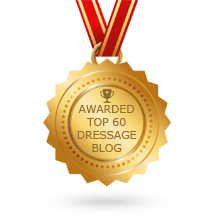 Arthur Kottas Heldenberg Arthur Kottas Heldenberg Talking with many people about dressage I have found that there are a lot of different interpretations of the terms used to describe the qualities we are trying to develop in our horses. I have looked at the Oxford Dictionary, the FEI Judging guidelines, and descriptions from the works of classical riders to try to find a common thread between them. In this and the next two blogs, I have attempted to draw together some of the differing concepts for commonly used terms. Rhythm The interpretation that generally comes to mind when talking about rhythm is “A strong, regular repeated pattern of movement or sound. A regularly recurring sequence of events or processes.” -oxfordenglishdictionaries.com For dressage, this dictionary definition is appropriate, however the FEI Dressage Hand Book Guidelines for Judging give a more precise definition relating to dressage: “The characteristic sequence of footfalls and phases of a given pace. “ In dressage terms, rhythm is the regularity of the foot falls the horse makes; it is not the speed of the footfalls, that’s the tempo. The following quote by Arthur Kottas Heldenburg from his book Kottas on Dressage, (page 100), expands on the definition and starts to define more of the qualities that are needed for a horse to have a good rhythm. “The rhythm is correct when the horse moves with ease, in a stable and balanced posture, active and relaxed at the same time. The horse feels good and works with pleasure; the rider is relaxed stable and can work without tiring.” The emphasis here is that the horse has learnt to balance himself through correct suppling exercises and has the strength to maintain the regular rhythm. Points to consider
Impulsion The definition on Impulsion from oxforddictionaries.com gives the impression of force or pressure being used, which is not quite in line with the dressage meaning: “the act of impelling or the state of being impelled motion produced by an impulse: propulsion a driving force; compulsion." The FEI Dressage Hand Book Guidelines for Judging gives a slightly different description: “Impulsion is the transmission of controlled, propulsive energy generated from the hindquarters in to the athletic movement of the eager horse. Its ultimate expression can be shown only through the horse’s soft and swinging back and is guided by a gentle contact with the rider’s hand.” Arthur Kottas Heldenburg From Kottas on Dressage page 203 “The propulsive energy generated by the horse’s hind quarters and controlled by the rider’s leg, seat and reins.” Nuno Oliveira’s description takes things a little further, showing that impulsion is more than just power or energy: “Impulsion can be defined as the ability by the horse to stay in the same cadence, the same position [attitude], with the same level of energy without the constant help of the rider.” Nuno Oliveira from “The Wisdom of Nuno Oliveira” by Antoine de Coux (page 74), and on page 67 “Impulsion has nothing to do with speed. Impulsion begins by the mind of the horse, not his legs.” By this he means that the horse must be willing to go forward when the rider lightly touches with the leg. The FEI definition only focuses on the physical side of impulsion i.e. the energy and where it is directed, and emphasizes a gentle contact through the reins. Classical dressage combines this with the attitude of the horse in terms of its self-carriage, enable through controlled strength and balance. Engagement For this term, the oxforddictionaries.com description is far from the meaning that dressage implies by the word. It defines engagement as : “The action of engaging or being engaged” However, the definition of Engage gives a more meaningful description in dressage terms “Engage, (with reference to a part of a machine or engine) move into position so as to come into operation.” If we take this explanation and relate it to the action of the horse’s haunches, it becomes more meaningful. The FEI Dressage Hand Book Guidelines for Judging shows it is more than simply bringing something into position, such as the horses haunches. “Hind legs stepping well under the horse’s body. Increased flexion of the joints of the hind quarters during its weight-bearing phase. This causes a relative lowering of the hind quarters/ raising of the forehand, thus shifting more of the task of load bearing to the hind quarters. A prerequisite for upward thrust/impulsion.” This explanation has a good description of the mechanics of engagement, but a horse cannot engage without impulsion, so you have a circle of requirement: increase the impulsion and you can increase the engagement. Arthur Kottas Heldenburg (from Kottas on Dressage page 203) describes engagement as “The hind limbs are said to be engaged when, during the forward (stance) phase of the movement, they are placed sufficiently forward under the horse’s mass to enhance balance and provide a good level of forward propulsion/lift.” Whilst these definitions give good descriptions of engagement, they don’t convey the whole picture. Engagement is part of a process that enables to horse to carry their weight towards the haunches and lighten the forehand. It is one element combined with balance, suppleness, rhythm and impulsion which brings the horse to its point of collection and lightness. ©Training Riders, Transforming Horses
Comments are closed.
|
AuthorDiane Followell Classical Dressage Trainer 
|
Telephone+44 (0)7931551014
|
|
© Diane Followell 2015 -2024.
All Rights Reserved.
All images and content are copyright Diane Followell unless otherwise stated.
All Rights Reserved.
All images and content are copyright Diane Followell unless otherwise stated.

 RSS Feed
RSS Feed

